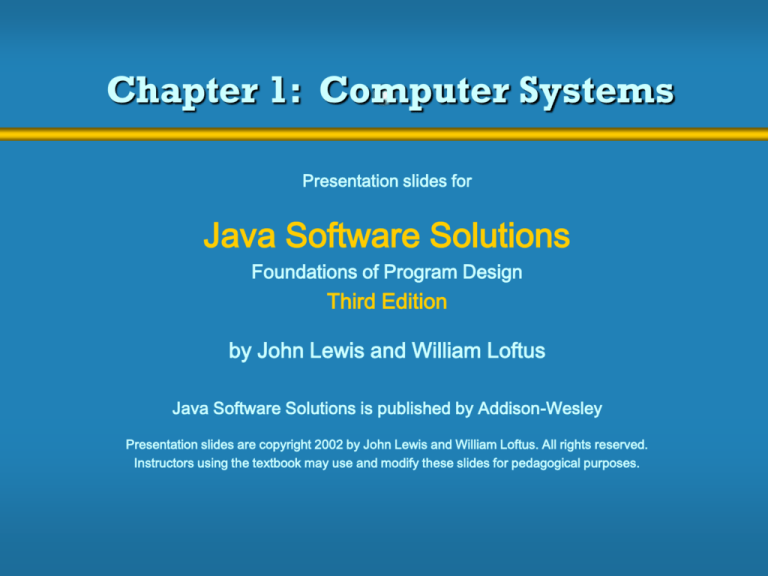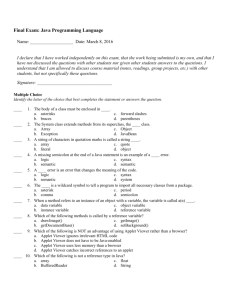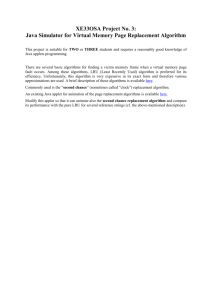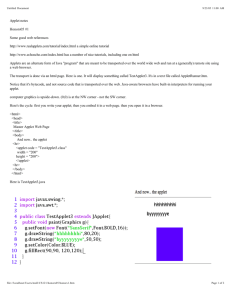
Chapter 1: Computer Systems
Presentation slides for
Java Software Solutions
Foundations of Program Design
Third Edition
by John Lewis and William Loftus
Java Software Solutions is published by Addison-Wesley
Presentation slides are copyright 2002 by John Lewis and William Loftus. All rights reserved.
Instructors using the textbook may use and modify these slides for pedagogical purposes.
Focus of the Course
Object-Oriented Software Development
• problem solving
• program design, implementation, and testing
• object-oriented concepts
classes
objects
interfaces
inheritance
polymorphism
• graphics and Graphical User Interfaces
• the Java programming language
2
Introduction to Graphics
The last one or two sections of each chapter of the
textbook focus on graphical issues
Most computer programs have graphical components
A picture or drawing must be digitized for storage on a
computer
A picture consists of pixels, and each pixel is stored
separately
3
Representing Color
A black and white picture can be stored using one bit per
pixel (0 = white and 1 = black)
A colored picture requires more information; there are
several techniques for representing colors
For example, every color can be represented as a
mixture of the three additive primary colors Red, Green,
and Blue
In Java, each color is represented by three numbers
between 0 and 255 that collectively are called an RGB
value
4
Coordinate Systems
Each pixel can be identified using a two-dimensional
coordinate system
When referring to a pixel in a Java program, we use a
coordinate system with the origin in the top-left corner
(0, 0)
112
X
40
(112, 40)
Y
5
Chapter 2: Objects and Primitive Data
Presentation slides for
Java Software Solutions
Foundations of Program Design
Third Edition
by John Lewis and William Loftus
Java Software Solutions is published by Addison-Wesley
Presentation slides are copyright 2002 by John Lewis and William Loftus. All rights reserved.
Instructors using the textbook may use and modify these slides for pedagogical purposes.
Objects and Primitive Data
Now we can explore some more fundamental
programming concepts
Chapter 2 focuses on:
•
•
•
•
•
•
•
•
predefined objects
primitive data
the declaration and use of variables
expressions and operator precedence
creating and using objects
class libraries
Java applets
drawing shapes
7
Applets
A Java application is a stand-alone program with a main
method (like the ones we've seen so far)
A Java applet is a program that is intended to be
transported over the Web and executed using a web
browser
An applet also can be executed using the appletviewer
tool of the Java Software Development Kit
An applet doesn't have a main method
Instead, there are several special methods that serve
specific purposes
8
Applets
The paint method, for instance, is executed
automatically and is used to draw the applet’s contents
The paint method accepts a parameter that is an object
of the Graphics class
A Graphics object defines a graphics context on which
we can draw shapes and text
The Graphics class has several methods for drawing
shapes
9
Applets
The class that defines an applet extends the Applet
class
This makes use of inheritance, which is explored in more
detail in Chapter 7
See Einstein.java (page 109)
An applet is embedded into an HTML file using a tag that
references the bytecode file of the applet class
The bytecode version of the program is transported
across the web and executed by a Java interpreter that is
part of the browser
10
The HTML applet Tag
<html>
<head>
<title>The Einstein Applet</title>
</head>
<body>
<applet code="Einstein.class" width=350 height=175>
</applet>
</body>
</html>
11
Drawing Shapes
Let's explore some of the methods of the Graphics
class that draw shapes in more detail
A shape can be filled or unfilled, depending on which
method is invoked
The method parameters specify coordinates and sizes
Recall from Chapter 1 that the Java coordinate system
has the origin in the top left corner
Shapes with curves, like an oval, are usually drawn by
specifying the shape’s bounding rectangle
An arc can be thought of as a section of an oval
12
Drawing a Line
10
150
X
20
45
Y
page.drawLine (10, 20, 150, 45);
or
page.drawLine (150, 45, 10, 20);
13
Drawing a Rectangle
50
X
20
40
100
Y
page.drawRect (50, 20, 100, 40);
14
Drawing an Oval
175
X
20
80
bounding
rectangle
Y
50
page.drawOval (175, 20, 50, 80);
15
The Color Class
A color is defined in a Java program using an object
created from the Color class
The Color class also contains several static predefined
colors, including:
Object
RGB Value
Color.black
Color.blue
Color.cyan
Color.orange
Color.white
Color.yellow
0, 0, 0
0, 0, 255
0, 255, 255
255, 200, 0
255, 255, 255
255, 255, 0
16
The Color Class
Every drawing surface has a background color
Every graphics context has a current foreground color
Both can be set explicitly
See Snowman.java (page115)
17
Chapter 3: Program Statements
Presentation slides for
Java Software Solutions
Foundations of Program Design
Third Edition
by John Lewis and William Loftus
Java Software Solutions is published by Addison-Wesley
Presentation slides are copyright 2002 by John Lewis and William Loftus. All rights reserved.
Instructors using the textbook may use and modify these slides for pedagogical purposes.
Program Statements
Now we will examine some other program statements
Chapter 3 focuses on:
•
•
•
•
•
•
program development stages
the flow of control through a method
decision-making statements
expressions for making complex decisions
repetition statements
drawing with conditionals and loops
19
More Drawing Techniques
Conditionals and loops can greatly enhance our ability to
control graphics
See Bullseye.java (page 189)
See Boxes.java (page 191)
See BarHeights.java (page 193)
20
Chapter 4: Writing Classes
Presentation slides for
Java Software Solutions
Foundations of Program Design
Third Edition
by John Lewis and William Loftus
Java Software Solutions is published by Addison-Wesley
Presentation slides are copyright 2002 by John Lewis and William Loftus. All rights reserved.
Instructors using the textbook may use and modify these slides for pedagogical purposes.
Writing Classes
We've been using predefined classes. Now we will learn
to write our own classes to define objects
Chapter 4 focuses on:
•
•
•
•
•
•
class definitions
encapsulation and Java modifiers
method declaration, invocation, and parameter passing
method overloading
method decomposition
graphics-based objects
22
Applet Methods
In previous examples we've used the paint method of
the Applet class to draw on an applet
The Applet class has several methods that are invoked
automatically at certain points in an applet's life
The init method, for instance, is executed only once
when the applet is initially loaded
The start and stop methods are called when the
applet becomes active or inactive
The Applet class also contains other methods that
generally assist in applet processing
23
Graphical Objects
Any object we define by writing a class can have
graphical elements
The object must simply obtain a graphics context (a
Graphics object) in which to draw
An applet can pass its graphics context to another object
just as it can any other parameter
See LineUp.java (page 257)
See StickFigure.java (page 259)
24
Chapter 5: Enhancing Classes
Presentation slides for
Java Software Solutions
Foundations of Program Design
Third Edition
by John Lewis and William Loftus
Java Software Solutions is published by Addison-Wesley
Presentation slides are copyright 2002 by John Lewis and William Loftus. All rights reserved.
Instructors using the textbook may use and modify these slides for pedagogical purposes.
Enhancing Classes
Now we can explore various aspects of classes and
objects in more detail
Chapter 5 focuses on:
•
•
•
•
•
•
•
•
object references and aliases
passing objects references as parameters
the static modifier
wrapper classes
nested classes and inner classes
interfaces
dialog boxes
GUI components, events, and listeners
26
Dialog Boxes
A dialog box is a graphical window that pops up on top of
any currently active window for the user
The Swing API contains a class called JOptionPane
that simplifies the creation and use of basic dialog boxes
There are three categories of JOptionPane dialog
boxes
• A message dialog displays an output string
• An input dialog presents a prompt and a single input text field
• A confirm dialog presents the user with a simple yes-or-no
question
See EvenOdd.java (page 302)
27
The EvenOdd Program
28
Graphical User Interfaces
A Graphical User Interface (GUI) is created with at least
three kinds of objects
• components
• events
• listeners
A GUI component defines a screen element to display
information or allow the user to interact with the program
• buttons, text fields, labels, menus, etc.
A container is a special component that holds and
organizes other components
• dialog boxes, applets, frames, panels, etc.
29
Events
An event is an object that represents some activity to
which we may want to respond
For example, we may want our program to perform some
action when the following occurs:
•
•
•
•
•
•
the mouse is moved
a mouse button is clicked
the mouse is dragged
a graphical button is clicked
a keyboard key is pressed
a timer expires
Events often correspond to user actions, but not always
30
Events and Listeners
The Java standard class library contains several classes
that represent typical events
Components, such as an applet or a graphical button,
generate (fire) an event when it occurs
Other objects, called listeners, wait for events to occur
We can write listener objects to do whatever we want
when an event occurs
A listener object is often defined using an inner class
31
Events and Listeners
Event
Component
Listener
This object may
generate an event
This object waits for and
responds to an event
When an event occurs, the generator calls
the appropriate method of the listener,
passing an object that describes the event
32
Listener Interfaces
We can create a listener object by writing a class that
implements a particular listener interface
The Java standard class library contains several
interfaces that correspond to particular event categories
For example, the MouseListener interface contains
methods that correspond to mouse events
After creating the listener, we add the listener to the
component that might generate the event to set up a
formal relationship between the generator and listener
33
Creating GUIs
To create a program with a GUI:
• define and set up the components
• create listener objects
• set up the relationships between the listeners and the
components which generate events of interest
• define what happens in response to each event
A push button is a component that allows the user to
initiate an action with the press of the mouse button
• defined by the JButton class
• generates an action event
A label is a component that displays a line of text (or an
image, or both)
• defined by the JLabel class
34
Creating GUIs
The init method of an applet can be used to set up the
GUI and add each component to the applet container
The Swing version of the Applet class is called JApplet
In a JApplet, components are added to the applet's
content pane
The content pane is retrieved using the getContentPane
method
A JButton generates an action event
See PushCounter.java (page 305)
35
The PushCounter Program
36
Action Listeners
The interface corresponding to an action event is called
ActionListener, which defines only one method, called
actionPerformed
The ButtonListener inner class implements the
ActionListener interface in the PushButton program
When the button is pushed, the JButton object invokes
the actionPerformed method, passing it an
ActionEvent
The listener method may or may not make use of the
event object passed to it
37
GUI Applications
A frame is a container component used for stand-alone
GUI-based applications
A panel is a container, but unlike a frame, it cannot be
displayed on its own
• it must be added to another container
• it helps organize the components in a GUI
See Fahrenheit.java (page 309)
See FahrenheitGUI.java (page 310)
38
The Fahrenheit Program
39
Chapter 6: Arrays
Presentation slides for
Java Software Solutions
Foundations of Program Design
Third Edition
by John Lewis and William Loftus
Java Software Solutions is published by Addison-Wesley
Presentation slides are copyright 2002 by John Lewis and William Loftus. All rights reserved.
Instructors using the textbook may use and modify these slides for pedagogical purposes.
Arrays
Arrays are objects that help us organize large amounts of
information
Chapter 6 focuses on:
•
•
•
•
•
•
•
•
array declaration and use
passing arrays and array elements as parameters
arrays of objects
sorting elements in an array
multidimensional arrays
the ArrayList class
polygons and polylines
more button components
41
Polygons and Polylines
Arrays often are helpful in graphics processing
Polygons and polylines are shapes that can be defined
by values stored in arrays
A polyline is similar to a polygon except that its endpoints
do not meet, and it cannot be filled
See Rocket.java (page 360)
42
The Rocket Program
43
The Polygon Class
The Polygon class, defined in the java.awt package
can be used to define and draw a polygon
Two versions of the overloaded drawPolygon and
fillPolygon methods each take a single Polygon
object as a parameter
A Polygon object encapsulates the coordinates of the
polygon
44
Check Boxes
A check box is a button that can be toggled on or off
A check box is represented by the JCheckBox class
A change of state generates an item event
The ItemListener interface corresponds to item
events
The itemStateChanged method of the listener
responds when a check box changes state
45
The StyleOptions Program
A frame is a container that can be used to create standalone GUI applications
A frame is represented by the JFrame class
A Font object represents by the font's:
• family name (such as Times or Courier)
• style (bold, italic, or both)
• font size
See StyleOptions.java (page 364)
See StyleGUI.java (page 365)
46
The StyleOptions Program
47
Radio Buttons
A set of radio buttons represents a set of mutually
exclusive options
When a radio button from a group is selected, the other
button currently "on" in the group is toggled off
A radio button generates an action event
See QuoteOptions.java (page 368)
See QuoteGUI.java (page 369)
48
The QuoteOptions Program
49
Inheritance and GUIs
An applet is an excellent example of inheritance
Recall that when we define an applet, we extend the
Applet class or the JApplet class
The Applet and JApplet classes already handle all the
details about applet creation and execution, including:
• interaction with a Web browser
• accepting applet parameters through HTML
• enforcing security restrictions
50
Inheritance and GUIs
Our applet classes only have to deal with issues that
specifically relate to what our particular applet will do
When we define the paint method of an applet, for
instance, we are actually overriding a method defined in
the Component class, which is ultimately inherited into
the Applet or JApplet class
51
The Component Class Hierarchy
The Java classes that define GUI components are part of
a class hierarchy
Swing GUI components typically are derived from the
JComponent class which is derived from the
Container class which is derived from the Component
class
Many Swing components can serve as (limited)
containers, because they are derived from the
Container class
52
Mouse Events
Events related to the mouse are separated into mouse
events and mouse motion events
Mouse Events:
• mouse pressed – the mouse button is pressed down
• mouse released – the mouse button is released
• mouse clicked – the mouse button is pressed down and released
without moving the mouse in between
• mouse entered – the mouse pointer is moved onto (over) a
component
• mouse exited – the mouse pointer is moved off of a component
53
Mouse Events
Mouse Motion Events:
• mouse moved – the mouse is moved
• mouse dragged – the mouse is dragged
To satisfy the implementation of a listener interface,
empty methods must be provided for unused events
An ArrayList object is used to store objects so they
can be redrawn as necessary
See Dots.java (page 427)
See DotsPanel.java (page 428)
54
The Dots Program
55
Mouse Events
Each time the repaint method is called on an applet,
the window is cleared prior to calling paint
Rubberbanding is the visual effect caused by "stretching"
a shape as it is drawn using the mouse
See RubberLines.java (page 431)
See RubberLinesPanel.java (page 432)
56
The RubberLines Program
57
Event Adapter Classes
Listener classes can be created by implementing a
particular interface (such as MouseListener interface)
A listener also can be created by extending an event
adapter class
Each listener interface has a corresponding adapter class
(such as the MouseAdapter class)
Each adapter class implements the corresponding
listener and provides empty method definitions
58
Event Adapter Classes
When we derive a listener class from an adapter class,
we override any event methods of interest (such as the
mouseClicked method)
Empty definitions for unused event methods need not be
provided
See OffCenter.java (page 435)
See OffCenterPanel.java (page 437)
59
The OffCenter Program
60






